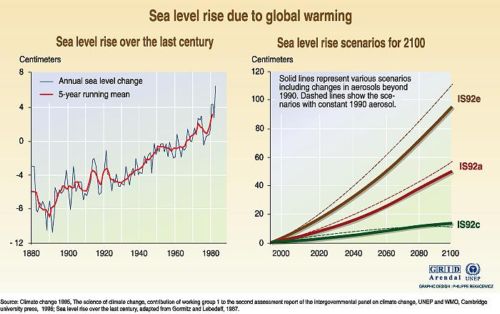Future effects:
Even the minimum predicted shifts in climate for the 21st century are likely to be significant and disruptive. Estimates of upcoming changes are wide-ranging. The global temperature may climb from 1.4 to 5.8 degrees C; the sea level may rise from 9 to 88 cm. This uncertainty reflects the complexity, interrelatedness, and sensitivity of the natural systems that make up the climate. Although scientific understanding and computer models have improved recently, projections to some extent still involve combining uncertain effects with uncertain effects.

Increases in sea level this century are expected to range from significant to catastrophic.
That doesn't mean the matter isn't serious. Predictions of future climate impacts may be fuzzy, but they are not meaningless: what they show is that the consequences could vary from disruptive to catastrophic. The minimum warming forecast for the next 100 years is more than twice the .6 degree C increase that has occurred since 1900. . . and that earlier increase is already having marked consequences. Extreme weather events, as predicted by computer models, are striking more often and can be expected to intensify and become still more frequent. Sea levels already have risen by 10 to 20 cm over pre-industrial averages and are certain to climb farther. A future of more severe storms and floods along the world's increasingly crowded coastlines is likely, and will be a bad combination even under the minimum scenarios forecast.
Although regional and local effects may differ widely, a general reduction is expected in potential crop yields in most tropical and sub-tropical regions. Mid-contintental areas -- such as the United States' "grain belt" and vast areas of Asia -- are likely to dry. Where dryland agriculture relies solely on rain, as in sub-Saharan Africa, yields would decrease dramatically even with minimal increases in temperature. Such changes could cause disruptions in food supply in a world is already afflicted with food shortages and famines.
Salt-water intrusion from rising sea levels will reduce the quality and quantity of freshwater supplies. This is a major concern, since billions of people already lack access to freshwater. Higher ocean levels already are contaminating underground water sources in Israel and Thailand, in various small island states in the Pacific and Indian Oceans and the Caribbean Sea, and in some of the world's most productive deltas, such as China's Yangtze Delta and Vietnam's Mekong Delta.
Most of the world's endangered species -- some 25 per cent of mammals and 12 per cent of birds -- may become extinct over the next few decades as warmer conditions alter the forests, wetlands, and rangelands they depend on, and human development blocks them from migrating elsewhere.
Higher temperatures are expected to expand the range of some dangerous "vector-borne" diseases, such as malaria, which already kills 1 million people annually, most of them children.
Source: http://unfccc.int/essential_background/feeling_the_heat/items/2905.php
